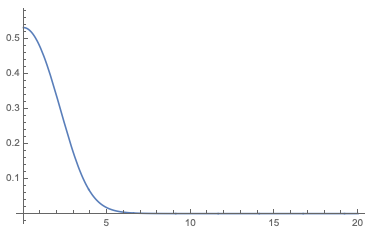In the past, we solved the radial wavefunction for the Woods-Saxon potential by Runge-Kutta method. But there is another method based on linear algebra, that all wave function can be expanded as a linear combination of a set of basis. In here, we use a free wave as basis, which is the spherical Bessel function.
to be annoying due to my poor memory , lets state the Schrödinger equation again,
Separating the radial part
replace
simplify
We can define a “free wave” Hamiltonian as
In this post, we explored the orthogonality of the the Riccati-Bessel function, and it is the eigen state for with eigenvalue of
.
Thus, the Riccati-Bessel function can be served as the set of basis functions that span the whole space.
The total Hamiltonian is then
Since the solution can be expressed as a linear combination of the basis functions, then
Multiple and integrate,
The above is a matrix equation
Everything seems OK. But when I test the theory using Mathematica, it fail. For simplicity, we use the s-orbital, and the basis is
The Woods-Saxon parameters are .
Using Runge-Kutta method, the ground state energy is -36.09 MeV, and the wave function is
We set , and
. The matrix elements is
where is neutron mass.
After calculate the matrix, find the eigenvalue and eigenstate. The lowest eigen energy is -465.18 MeV, which indicate something wrong. And the wave function, constructed by the eigenstate look likes
The shape of the wavefunction looks similar to the correct wavefunction, but narrower and larger amplitude.
The next eigen wave function also look like 1s-orbital. The spectrum of the eigenvalues, which are the eigen energies, has 7 bound states.
I don’t know the problems….
One possible reason could be that the basis function is always , but the real solution is not necessary to be
. In fact, the 0s-wave function never be zero except
.
I use the same basis and extract the coefficient,
And it can reproduce the original wave function at
Since the basis function is a sine wave and we only sum limited term, the long range oscillation can not be suppressed.
Another possible reason is that the basis is not normalizable. This root at the orthogonality of Bessel function that
An-another possible reason is that, the basis is for unbound state. But in this post, we used a not-normalizable, unbounded basis to construct the bound state wave function. It can form the solution correctly at short-range, but it is periodic. This is the nature of series expansion, always periodic.
In this sense, we are also expanding the solution into a series, that the series only produce periodic function, therefore, a correct way to do is using the spherical Hankel transform, which is transform the Schrodinger equation into momentum space.












